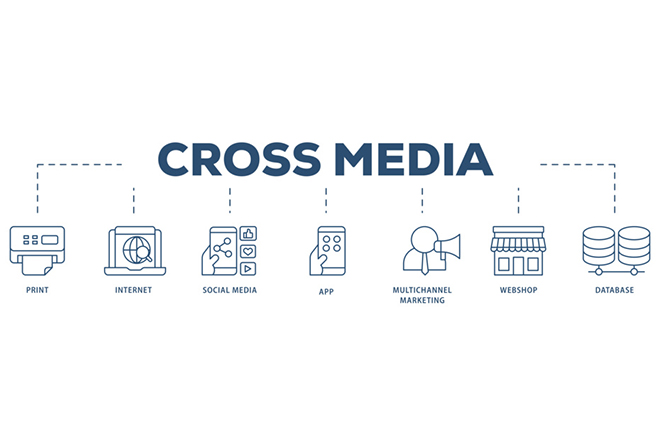Practical logic of media integration

Integrating the media is a great task. Photo: TUCHONG
With the embedding of digital and artificial intelligence technologies, media integration has achieved new breakthroughs. In the era of digital intelligence, the focus of integrated thinking has begun to shift from media-centric towards user-centric. Intelligent technology continuously empowers and deeply integrates into the full cycle and entire process of media integration. The digital intelligent infrastructure for media integration is gradually taking shape.
User-centeredness
User-centeredness is an inevitable trend in the development of media integration. Firstly, one of the essential requirements of Chinese modernization, as proposed at the 20th CPC National Congress, is the development of whole-process people’s democracy. Media practices centered on users within the media integration development process interpret “developing whole-process people’s democracy” through a people-oriented approach. Secondly, digital intelligent technologies have deepened users’ dependence on smart devices and mobile terminals, altering users’ habits of information consumption and shifting the focus of media integration practices. Finally, from the intrinsic logic of media integration practices, a user-centric characteristic is significant. With its starting point and foothold centered around users, it aims to provide them with more convenient services. Additionally, users hold a positive and optimistic attitude towards the overall development of media integration. This indicates that a user-centric approach is conducive to the development of media integration.
The key words in user-centric media integration practices are “constructiveness” and “service.” Constructive practices of media integration mainly consist of two aspects. First, they involve producing positive and constructive high-quality media products oriented towards users, with a focus on constructive content. Second, they emphasize actively engaging users by encouraging their participation in communication.
Service-oriented practices of media integration mainly consist of three aspects: information services, government services, and public services. In terms of information services, media integration can enable accurate content delivery.
In the aspect of government services, the “media + government affairs + services” model has become a primary convergence practice. The key lies in providing users with more convenient services related to government affairs, creating a bridge of communication between the government and the public.
In terms of public services, media integration practices should move beyond the traditional media perspective and focus on users’ needs.
Digital intelligent infrastructure
The digital intelligent infrastructure for media integration refers to a technological or intelligent foundation supported by digital technology and artificial intelligence that serves as the technological starting point for in-depth media integration.
At present, the digital intelligent infrastructure for media integration practices is specifically manifested in three areas: communication scenarios, communication modes, and communication ecosystems.
From the perspective of communication scenarios, in the current stage of technological development, audio and video outputs are profoundly changing user behavior patterns, shifting users from being “permanently online” to being “permanently on the spot.” In intelligent media integration practices, scenarized audio and video communication has become the new normal.
From the perspective of communication modes, artificial intelligence-generated content (AIGC) has already been incorporated into the top-level design and news practices of most mainstream media outlets as the infrastructure for media integration. It is foreseeable that AI, virtual digital humans, and similar technologies will accelerate the generative transformation of media and rebuild the practical path of media integration.
From the perspective of the formation of communication ecosystems, the emergence of the “intelligent+” ecosystem signifies the refinement of the digital intelligent infrastructure of media integration. “Wired+5G” empowers media integration, while the media intelligent middle platform becomes a new platform for media integration.
The formation of digital intelligent infrastructure has facilitated the success of media integration practices in several ways. Firstly, experiential cultural consumption, characterized by digital immersion and the integration of virtual and real elements, has gone mainstream, and “new retail” models as well as new consumption modes and consumption scenarios such as digital collectibles, are starting to emerge. Secondly, it has promoted the construction of primary-level communication systems and facilitated the modernization of primary-level governance.
New landscape
Faced with new opportunities presented by the gradual formation of digital intelligent infrastructure for media integration, driving innovation in internal and external communication narrative systems through in-depth integration and reshaping the mainstream public opinion landscape is an important step in current media integration practices.
In-depth integration to drive transformation in international communication is a distinctive practice of media integration, which is mainly manifested in two aspects.
First, the overseas influence of domestic mainstream media continues to grow. Numerous influential top accounts have formed comprehensive overseas social media matrices, achieving high user reach and outstanding dissemination effects. At the same time, new media and integrated reporting have become the main choice of mainstream media in international news reporting.
Second, applying integrated thinking to external communication narrative methods focuses on issues related to common human interests. By adopting a narrative perspective from the “other,” emotional interactions between Chinese and foreign audiences could be achieved.
The practical logic of media integration in the digital era represents a new social networking model of practice that transcends the media field and connects everything intelligently. In the future, in-depth media integration should be driven by digital intelligent technology. It should break through traditional temporal and spatial dimensions, reconfigure and integrate resources, and illuminate people’s quality digital lives by creating a new ecosystem of three-dimensional integration interactions among “people-media-society.”
Yin Le is a professor from the School of Journalism and Communication at the University of Chinese Academy of Social Sciences.
Edited by ZHAO YUAN
